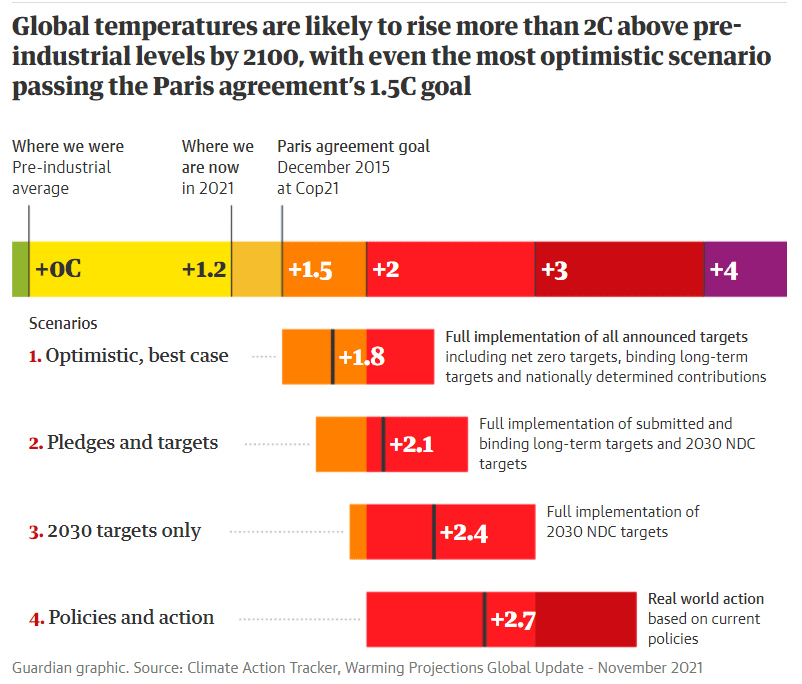SHARE
Thoughts
What is a COP?
A Conference of the Parties (COP) is an annual meeting of the signatories to a UN convention – an agreement to co-operate to tackle a global challenge. In the case of climate change, there are almost 200 states who have signed the UN Framework Convention on Climate Change (UNFCCC) since its creation at the Earth Summit in Rio in 1992.
At each COP meeting the details of how to co-operate, who will act and to what end is refined. In between each annual meeting there are a series of preparatory meetings of government officials and elected representatives. The progress in those intermediate talks can provide an indication of the political significance of each COP and its perceived success.
The first agreement to act was the Kyoto Protocol signed in 1997, and this was superseded by the now famous Paris Agreement in 2015.
This global political platform follows the success of the Vienna Convention and subsequent Montreal Protocol, signed from 1987, to reduce the production and use of ozone depleting substances which created a whole in the Ozone layer. Amended in Kigali in 2016 to tackle F-gases, which also have a significant contribution to global heating.
Other related UN conventions, which have had less success to date, include the Convention on Biological Diversity. Whose COP15 took place online in October and will continue in Kunming in 2022.
Everything you need to know about COP26
We must prepare for at least 2°C of global heating. That’s the implicit outcome of COP26. The decisions which have been agreed upon by global leaders don’t meet the aspirations of the Paris Agreement to limit the average global temperature increase to well below 2°C; ideally to 1.5°C. This inevitably means that more lives will be lost and more economic damage will be done as a result of man-made climate change.

There is an obvious gap between meaningful action and all of the Net Zero announcements and the political fanfare about climate action. A report published during COP26 by Climate Action Tracker shows that we have a 66% probability of exceeding 2°C of global heating. It highlights the ‘credibility gap’ between all of this talk, and the intended action. That’s based on their review of the Nationally Determined Contributions (NDCs) – essentially each nation’s plan to reduce their Greenhouse Gas (GHG) emissions.
It assumes that these NDCs are fully implemented. We know that the best laid plans of Governments are never fully implemented, for instance the UK’s Building Regulations to limit energy consumption and GHG emissions are not enforced. Every new building emits more in operation than the design intent.
The Climate Action Tracker report is reinforced by analysis from CarbonBrief of three similar studies, which have reached a similar conclusion about the present best-case scenario being >2°C.[1]
When we talk of adapting to 2°C of global heating, it might not seem like much of a change. In the UK, it can lead to talk of a Mediterranean climate and an increasing number of vineyards. The truth is that this average temperature increase will be unevenly distributed and it will affect us all. We will experience more frequent and more extreme weather events. Those peoples closer to the equator and in the Global South will be disproportionately affected. The locations which are more climate resilient will become much clearer over the coming years, which will be reflected in their desirability and value.
We need to think about how this could affect our buildings and infrastructure. How well protected are they from flood risks, heat stress, wildfires and storms, and who bears the costs when damage is done?
The next two COPs, in 2022 and 2023, will be in locations which are closer to the equator and with a significant exposure to a changing coastline and increasing desertification – these are COP27 in Sharm El-Sheikh in Egypt and then COP28 in the United Arab Emirates. It is likely that the immediate effects of climate change will be closer at hand and more visible than in Glasgow.
The State of Climate in Africa Report states that ‘by 2030, it is estimated that up to 118 million extremely poor people will be exposed to drought, floods and extreme heat in Africa”. In Madagascar, according to the World Food Programme, more than 1 million people are suffering right now from the first famine caused by climate change.
However, the 5-year cycle of submitting NDCs means that we could be five COPs away, in 2027, from the national action we need. That’s in the context of the need to halve emissions by 2030 and then halve them again by 2040. We’re running out of time and that is why we need to adapt.
Next year we will see the scientists of the Intergovernmental Panel on Climate Change (IPCC) publish their sixth assessment report (AR6). It is expected to forewarn us that the time left to take climate action is reducing and could be as little as four years. The AR6 Working Group I presented to COP26 and stated that ‘climate and weather extremes and their adverse impacts on people and nature will continue to increase with every additional increment of rising temperatures’. We know that there has already been lobbying by governments to weaken the text of AR6 which describes the latest climate change science.[2]
It is not surprising that this slow action and blocking of progress is causing ‘climate anxiety’ amongst young people, mentioned by Barack Obama in his COP26 speech. Greta Thunberg summed up her frustrations on Twitter, “Unless we achieve immediate, drastic, unprecedented, annual emission cuts at the source then at means we’re failing when it comes to the climate crisis.”
When a credibility gap exists between political announcements and concrete actions on climate change, particularly when it is seen as unjust and deadly, we can expect more peaceful protests and civil unrest. Obama has recommended Kim Stanley Robinson’s novel The Ministry of the Future. This describes a bleak future where a new global Ministry is created to protect the rights of future life on Earth after a catastrophic heatwave in India. It is a well-informed novel about climate change, but it does take these protests to the extremes of terrorist activity which is not an outcome any of us wish to see.
There were many global leaders at COP26, including President Biden, Bill Gates and Greta Thunberg, however there was also notable exceptions like President Xi Jinping. A mixed message from China when there is a concerted effort from the country’s leadership to act on climate change. There are signs of collaboration between the USA and China, including a joint statement and close negotiations in the final hours of COP26 between John Kerry, a hero of the Paris and Kigali negotiations, and Xie Zhenhua, China’s Climate Envoy. Xie has described climate change as an “existential crisis”.
Reasons for hope
There are reasons for hope from COP26. It is clear that there was a lot of energy at COP26, in the Blue and Green zones as well as on the fringes. More public and private sector commitments have been made than ever before. For example, India committed to a target of Net Zero emissions by 2070. Over $130tn AUM are now Net Zero aligned via the Glasgow Financial Alliance for Net Zero (GFANZ). Over half of the FTSE100 companies, with a market cap of over £1.2tn, have committed to be Net Zero Carbon by 2050.
The Chancellor, Rishi Sunak, announced that the UK will become the ‘world’s first net zero aligned financial centre’ with plans to publish a Net Zero Transition Pathway next year. This was supported by FCA announcements on a new ESG Strategy and a Disclosures & Labels Advisory Group for sustainable investments to support the development of the Sustainable Disclosure Regulation (SDR).
As regions and countries publish regulations to increase transparency of climate risks across all asset classes, the long-expected announcement by the IFRS Foundation that the International Sustainability Standards Board (ISSB) had been formed, was welcomed. This is an important step in standardising company reporting as it joins together the Value Reporting Foundation and Climate Disclosure Standards Board (CSDB), and builds on the Taskforce on Climate-related Financial Disclosures (TCFD) Recommendations.
For the UK, a Net Zero Whole Life Carbon Roadmap to 2050 was published by UKGBC.
Whilst there is obviously a concerted effort to mobilise private climate finance, there is still a shortfall in the $100bn (0.001% of global GDP) by 2020 commitment of finance for developing countries to enact necessary climate mitigation measures. At the same time, there continues to be $500bn of government subsidies for fossil fuels and the same amount to farming practices that damage our planet and our health.
Some small concessions were made at COP26 to increase this funding, such as the Breakthrough Agenda, MOBILIST, the Clean Green Initiative and the Climate Investment Funds’ Capital Markets Mechanism, specifically for clean technology including renewables and electric vehicles. The Urban Climate Action Programme will support cities in Africa, Asia and Latin America to transition to Net Zero by 2050. An Adaptation Fund and the Climate Action for a Resilient Asia (CARA) programme will support measures to improve climate resilience in Asia-Pacific cities.
For the UNFCCC process, the technology mechanism is led by the Technology Executive Committee (TEC) and the Climate Technology Centre and Network (CTCN). It can provide a focus for incubation and acceleration of relevant cleantech.
Over the last year, we have seen a number of initiatives to phase out coal power, including significant private divestment and China, Japan, Korea and the G20 commitments to end overseas funding of coal. At COP26, 190 countries and organisations agreed to end all investment in coal power generation. For major economies, this will be in the 2030s and in the 2040s for the rest of the world.[3]
Momentum is also building for the phase of the internal combustion engine, with a COP26 declaration to work towards 100% zero emission vehicles sales globally by 2040. This includes commitments from Ford, GM, Mercedes-Benz and Volvo, but not Toyota, VW and Nissan-Renault.
The USA, EU and UK also endorsed five principles for infrastructure development:[4]
- Infrastructure should be climate resilient and developed through a climate lens.
- Strong and inclusive partnerships between host countries, developed country support, and the private sector are critical to developing sustainable infrastructure
- Infrastructure should be financed, constructed, developed, operated, and maintained in accordance with high standards.
- A new paradigm of climate finance—spanning both public and private sources—is required to mobilize the trillions needed to meet net-zero by 2050 and keep 1.5 degrees within reach.
- Climate-smart infrastructure development should play an important role in boosting economic recovery and sustainable job creation.
These principles may be seen in practice in the Build Back Better World, Global Gateway and Clean Green initiatives.
Nature-based Solutions to climate change were also a big theme at COP26. This follows a clearer scientific understanding of the need to tackle both climate change and biodiversity loss at the same time, as well as growing interest in the Taskforce for Nature-related Financial Disclosure (TNFD).
The Glasgow Leaders’ Declaration on Forests and Land Use saw over 100 leaders, accounting for 86% of the world’s forests, commit to halting and reversing forest loss and land degradation by 2030. This was reinforced by an increase in the number of NDCs which include measures to reduce nature loss.[5] However, more is required for agriculture, which occupies half of the habitable land on Earth, and is still missing from many NDCs, with significant uncertainty about the related national emissions.[6]
Glasgow Climate Pact
Despite Alok Sharma’s best efforts, this compromised Pact will be seen as a political failure by many parties who do not have a vested interest in the fossil fuel-driven status quo. It is the first time a COP decision has recognised that there is an end for fossil fuels. Stopping the use of coal is considered a necessity to achieve 1.5°C – 8,500 coal plants would have to be closed by 2030 according to the IEA – and this part of the Pact was weakened.
The late intervention by India to change the wording of the agreement to ‘phasing down of unabated coal power and inefficient fossil fuel subsidies’ rather than ‘phasing out’ would not have been possible without the support of China and, in turn, the USA. It is a clear demonstration of how these politics work at the end of a very long extra day, and it provides a short extension in the support for fossil fuel power.
There has been progress since Paris. We have seen agreement of the ‘Paris Rulebook’, which is an important step in the implementation of the Paris Agreement, and this will ensure we see a ratcheting up of action.
In terms of the hope for achieving a temperature increase of well below 2°C, with a continued aspiration for 1.5°C, the Pact (article 29) does introduce a new annual ratchet mechanism – to revisit the NDCs in 2022 rather than in five years. There is a hope that they can be improved and it raises the stakes for COP27 in Egypt next year. The AR6 Working Group II will present to COP27 on adaptation.
The parties also recognise the concept of developed countries making payments to developing countries for ‘loss and damages’ for historic emissions which are causing damage now. This will be an ongoing dialogue and a reminder of the meetings which take place between each COP. There is a UN Subsidiary Body for Implementation (SBI) and it is focused on the implementation of the Paris Agreement and this Glasgow Climate Pact. SBI meetings 56-60 will take place between 2022-2024. Technical assistance will be provided via the Santiago Network.
If you want to see how fast we can progress politically keep an eye on the SBI and the other intervening UNFCCC meeting over the coming year. For future COPs we can expect the increasingly diverse involvement of women leaders, young people, indigenous people and local communities.
The collective efforts to tackle climate change, and the related challenge of biological diversity, will only ratchet-up over the next five years as we see increasing losses and damages from insufficient action. Decisions about what, how and when to invest and finance assets will have to consider this complex, dynamic landscape with a need to balance both climate adaptation as well as mitigation.
[1] https://www.carbonbrief.org/analysis-do-cop26-promises-keep-global-warming-below-2c
[2] https://www.bbc.co.uk/news/science-environment-58982445
[3] https://www.gov.uk/government/news/end-of-coal-in-sight-as-uk-secures-ambitious-commitments-at-cop26-summit
[4] https://www.gov.uk/government/news/us-president-biden-european-commission-president-von-der-leyen-and-pm-boris-johnson-announce-commitment-to-addressing-climate-crisis-through-infras
[5] https://wwf.panda.org/wwf_news/?4248391/NDCsreport
[6] https://ccafs.cgiar.org/resources/tools/agriculture-in-the-ndcs-data-maps-2021



